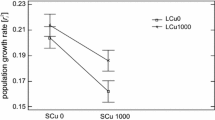Abstract
Three populations of Dimorphotheca pluvialis (L.) Moench were subjected to mass selection for increased oil content. After three cycles of selection, at a selection intensity of 10%, in all three populations a significant increase in oil content was observed. The average gain in oil content per selection cycle varied from 0.5% to 1.2%. Realised heritabilities ranged from 0.15 to 0.58. It is likely that the observed differences in response and heritability for oil content can be attributed to different genetic constitutions of the populations used. Though heritabilities are specific for populations, selection procedures and environmental circumstances, the observed values for the realised heritabilities indicate that a substantial part of the phenotypic variance is additive genetic variance. Therefore, continued (mass) selection for increased oil content will be effective in Dimorphotheca.
Similar content being viewed by others
References
Barclay, A.S. & F.R. Earle, 1965. The search for new industrial crops V. The South African Calenduleae (Compositae) as a source of new oil seeds. con Bot 19: 33–43.
Binder, R.G., T.H. Applewhite, M.J. Diamond & L.A. Goldblatt, 1964. Chromatographic analysis of seed oils II. Fatty acid composition of Dimorphotheca oil. J Am Oil Chem Soc 41: 108–111.
Derksen, J.T.P., B.G. Muuse, F.P. Cuperus & W.M.J. van Gelder, 1993. New seed oils for oleochemical industry: evaluation and enzyme-bioreactor mediated processing. Ind Crops Prod 1: 133–139.
Earle, F.R., K.L. Mikolajczak, I.A. Wolff & A.S. Barclay, 1964. Search for new industrial oils X. Seed oils of the Calenduleae. J Am Oil Chem Soc 41: 345–347.
Falconer, D.S., 1989. Introduction to Quantitative Genetics. 438 pp. Longman Scientific & Technical, United Kingdom.
Genstat 5 Committee, 1989. Genstat 5 Reference Manual. 749 pp. Oxford University Press, United Kingdom.
Groenendijk, F.P.F. & R. Frankhuizen, 1993. Niet-destructieve bepaling van het oliegehalte van oliehoudende zaden met NIRSpectrometrie. Report no. 93.21. 26 pp. RIKILT-DLO, Wageningen, the Netherlands (in Dutch).
Hill, W.G., 1972. Estimation of realised heritabilities from selection experiments II: Selection in one direction. Biometrics 28: 767–780.
Hof, L., 1996. Dimorphotheca pluvialis: a new source of hydroxy fatty acid? In: J. Janick (Ed), Progress in New Crops. Proceedings of the Third National Symposium on New Crops, Indianapolis, pp. 372–376. ASHS Press, USA.
Knowles, R.E., L.A. Goldblatt, G.O. Kohler, S.J. Toy & J.R. Haun, 1965. Oil seed composition of two species of Dimorphotheca grown at five locations in the United States. Econ Bot 19: 262–266.
Kreuzer, A.D.H., E.W.J.M. Mathijssen & W.J.M. Meijer, 1996. Gewasgroei en zaadvorming van Dimorphotheca pluvialis en Osteospermum ecklonis. Report no. 60. 45 pp. AB-DLO, Wageningen, the Netherlands (in Dutch).
Lühs, W. & W. Friedt, 1994. The major oil crops. In: D.J. Murphy (Ed), Designer Oil Crops: Breeding, Processing and Biotechnology, pp. 5–58. VCH, Germany.
Meier zu Beerentrup, H. & G. Röbbelen, 1987. Screening for European productions of oilseed with unusual fatty acids. Angew Botanik 61: 287–303.
Mesken, M., 1987. Mass selection for crown height in sugar beets (Beta vulgaris L.). 1: Divergent selection in diploids. Euphytica 36: 129–145.
Mulder, F., L.J.M. Van Soest, E.P.M. De Meijer & S.C. Wallenburg, 1992. Current Dutch research on new oilseed crops. In: H.H. Naqvi, A. Estilai & I.P. Ting (Eds), Proceedings of the First International Conference on New Crops and Products, Riverside, USA, pp. 17–22. Univ. of Arizona, Tucson, USA.
Muuse, B.G., F.P. Cuperus & J.T.P. Derksen, 1992. Composition and physical properties of oils from new oilseed crops. Ind Crops Prod 1: 57–65.
Norlindh, T., 1977. Calenduleae-systematic review. In: V.H. Heywood, J.B. Harborne & B.L. Turner (Eds), Biology and Chemistry of the Compositae, pp. 961–987. London, Academic Press, United Kingdom.
Princen, L.H. & J.A. Rothfus, 1984. Development of new crops for industrial raw materials. J Am Oil Chem Soc 61: 281–289.
Sengers, H.H.W.J.M. & R.A.C. Koster, 1995. Marktonderzoek nieuwe technische oliën. 48 pp. LEI-DLO, Den Haag, the Netherlands (in Dutch).
Thompson, A.E., D.A. Dierig & G.A. White, 1992. Use of plant introductions to develop new industrial crop cultivars. In: H.L. Shands, & L.E. Wiesner (Eds), Use of Plant Introductions in Cultivar Development, Part 2, pp. 9–48. Crop Sci Soc Am Special Publication No. 20. Madison, USA.
Van Dijk, N. & G. Borm, 1994. Teeltproeven Bekergoudsbloem. Interne Mededeling 1062. 71 pp. PAGV-DAT, Lelystad, the Netherlands (in Dutch).
Van Soest, L.J.M., 1990. Introduction and breeding of new oil crops. In: J.A.M. De Bont (Ed), Biotechnology and Fatty Acids: New Perspectives for Agricultural Production? Proceedings of a Discussion Meeting, Wageningen, the Netherlands, 1989, pp. 36–44. Pudoc Wageningen, the Netherlands.
Van Soest, L.J.M. & F. Mulder, 1993. Potential new oilseed crops for industrial use. Lipid Techn 5: 60–65.
Van Soest, L.J.M., 1994. New vegetable oils for non-food use. Agro-Food-Industry Hi-Tech 5: 14–18.
Author information
Authors and Affiliations
Rights and permissions
About this article
Cite this article
Hof, L., Nieboer, I. & Dolstra, O. Response to mass selection and estimation of heritability for oil content in Dimorphotheca pluvialis. Euphytica 106, 111–116 (1999). https://doi.org/10.1023/A:1003596216018
Issue Date:
DOI: https://doi.org/10.1023/A:1003596216018




